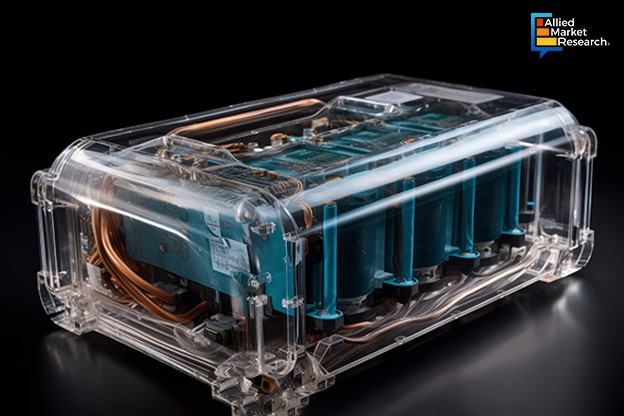How are Battery Management Systems Expanding the Scope of Battery Manufacturing Businesses?

20 Feb
2024
Highlights:
- Introduction
- Development of different BMS architectures
- Advantages of battery management systems
- Recent trends and advancements in the battery management system industry
Though battery packs have been in use for a long time now, the rising adoption of electric vehicles has ushered in a new age of battery technologies. Today, research in electric vehicles is centered around improving the quality and stability of battery packs and making them energy-efficient. The emergence of the battery management system (BMS) can be attributed to this trend. Battery management systems, in the simplest terms, can be defined as an electronic system that offers protection to rechargeable battery packs from operating outside their safe operating zone. The safe operating area of a battery refers to the voltage and current levels within which the battery operates to its fullest potential.
To ensure that the battery stays within its safe operating area, BMS monitors various battery parameters such as charging state, voltage and current levels, temperature, power consumption, operating efficiency, etc. Moreover, BMS is also equipped with certain characteristics that allow it to control the battery’s environment and regulate it. The primary aim behind designing BMS is to ensure that residual energy in battery cells is used optimally and to avoid any occurrence of fast charging and discharging.
How have battery management systems evolved in recent times?
Over the years, BMS has evolved considerably to align with the changing nature of battery technology. As a result, different BMS architectures have been developed based on installation type. For instance, in centralized BMS architecture, all battery packs are connected to the management system directly. Centralized BMS has certain inherent advantages; firstly, these systems are easier to design as the battery packs are connected to a single controller. Moreover, since the number of electrical components required for connections is less, the cost of assembling the battery unit and maintenance is minimal. Owing to these benefits, the centralized segment of the battery management system industry is anticipated to rise at a CAGR of 20.9% during the 2023-2032 period.
Distributed BMS architecture, on the other hand, refers to each battery cell being controlled by a separate BMS controller. Thus, each BMS controller is independent of the other and, hence, the computation of different battery packs takes place separately. The biggest advantage of distributed BMS is that it can be easily scaled by just adding battery packs along with their controllers. This utility of distributed BMS architecture has exponentially enhanced its applicability which is expected to help the distributed segment to surge ahead at a CAGR of 19.6% by 2032.
The third type of BMS architecture, i.e., modular architecture combines the best of the other two technologies. Modular BMS architecture has partitions between different battery packs and each partition has its controller. However, these battery packs are interconnected to each other and the central controller. This architecture type has witnessed a huge growth in popularity owing to its scalable and reliable nature. The modular segment is predicted to grow at a CAGR of 18.6% by 2032 on account of its rise in demand from various industries.
Reasons behind the rising adoption of battery management systems (BMS)
BMS architecture has become indispensable for modern battery systems. BMS architecture is now widely used in several industries including automotive manufacturing, consumer electronics, and telecommunication. Certain important advantages offered by this technology are discussed below:
Improved safety
A major hurdle that has slowed down the shift to electric vehicles (EVs) is the lack of safety associated with the battery systems used in these automobiles. However, with the advent of BMS architecture, this problem is likely to be solved. BMS architecture provides stability to the battery packs and reduces the occurrence of short circuits and thermal runaways. Moreover, in some extraordinary cases, it disconnects the battery from the main system to prevent disastrous accidents.
Improved battery life
Issues such as overcharging and thermal stress can damage the lifespan of batteries. BMS architecture, through continuous monitoring of parameters like temperature and state of charge, brings down the chance of battery draining and battery overheating. This keeps the battery functional for a longer time and, ultimately, increases the lifespan of the battery.
Cell balancing
A battery pack is made up of multiple cells which, in some cases, might have different voltages and characteristics. This results in imbalances in the battery packs, leading to a substantial decrease in the operational efficiency of the battery pack. BMS plays a key role in managing these cell imbalances by redistributing power and charging the individual cells to a uniform voltage, thus restoring the efficiency of the battery pack.
Latest trends in BMS architecture that your business should pay attention to
Just like most other sectors, the battery management system industry is experiencing the integration of Artificial Intelligence and machine learning in BMS architecture. These emerging technologies are now used for predictive analysis and adaptive control of battery systems, thus assisting in proactive maintenance of the battery systems. Moreover, the ability of these technologies to store large amounts of data helps in better analysis of battery functioning. Furthermore, research on incorporating cloud technology in BMS architecture has produced some stunning results. Merging cloud connectivity features in battery management systems has helped in remote monitoring of battery health. Additionally, the development of thermal management systems might further augment the capabilities of BMS architecture in regulating the temperature of battery packs.
To summarize, BMS architecture has become an important component of modern-day battery systems. Depending on the type of battery and its installation pattern, three BMS architectures have been developed viz., centralized, distributed, and modular BMS. These BMS architectures enhance the safety, stability, and efficiency of battery packs significantly. Furthermore, innovations in BMS, along with the integration of advanced technologies such as AI, ML, advanced thermal systems, etc., are expected to open up new avenues for the growth of the industry.
For an in-depth analysis of various growth drivers and opportunities in the industry, feel free to contact us.

Rosy Behera
Author's Bio- Rosy Behera holds a bachelor’s degree in Electrical and Electronics Engineering and now she is a content writer by profession. She loves to portray her thoughts and ideas with a nice command of words. Grabbing an audience with her creative write-ups is one of her biggest assets so far. Apart from writing, she is a certified “Odisi” dancer and has done Gardharva in Drawing, Painting, and Arts. She always explores new things through travel and is a big foodie.
Avenue: Entire Library membership of Allied Market Research Reports at your disposal
- Avenue is an innovative subscription-based online report database.
- Avail an online access to the entire library of syndicated reports on more than 2,000 niche industries and company profiles on more than 12,000 firms across 11 domains.
- A cost-effective model tailored for entrepreneurs, investors, and students & researchers at universities.
- Request customizations, suggest new reports, and avail analyst support as per your requirements.
- Get an access to the library of reports at any time from any device and anywhere.
Related Post
-
How are Submarine Cables Transforming Global Connectivity with Enhanced User Experience?
-
Endoscopy Procedures: Transformations in Techniques and Applications
-
AI-Powered Video Analytics: How the Product Actually Works for enterprises
-
Painting Robots: Transforming Precision Coating and Creative Applications
-
Innovations in Pharmacovigilance Systems Advancing Patient Safety
-
Understanding Edge Security: Keeping Data Safe Near the Source
-
Exploring the Use and Advancements of 3D Laser Scanners in Professional Applications
-
Reinforcing Industrial Controls with Smarter Tools and Training








